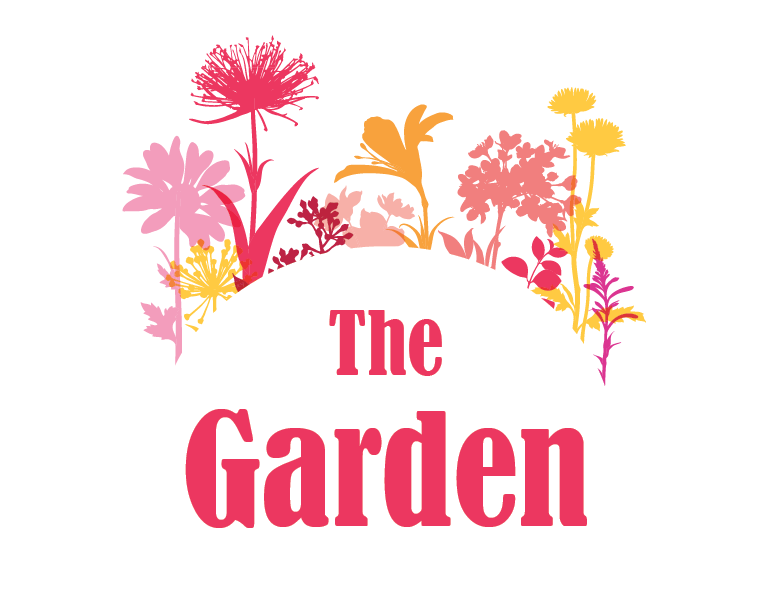
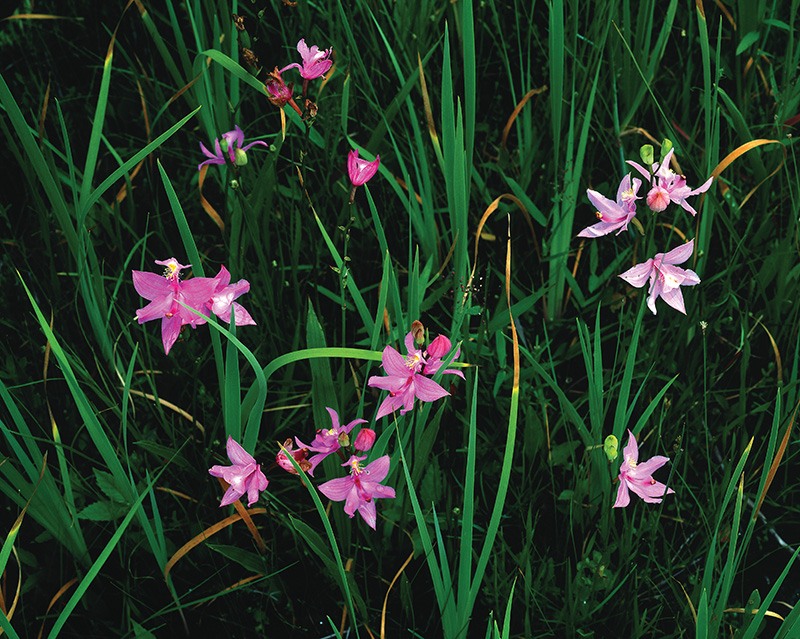
Story and Photos by William Burt
Wildflowers—on my own home turf here, at the southern end of the Connecticut: this should be fun.
I’ve sketched up a little area tour, recalling species I’ve encountered in past years, and stopping here and there to reflect on some of the most notable. Although the ones “most notable,” I fear, are usually those that have obliged me in my efforts with a camera; so, might there be a little favoritism going on? Fair warning. And by the way—last caveat—I am no botanist. I write here only as a once bird-crazed, birds-only naturalist whose eye began to stray to other features of the natural scene, and soon saw what a photograph could be with a good splattering of flowers.
Okay, so much for caveats. We’ll start in the spring woods of Lyme, then jump up to East Haddam for some orchids; then turn west for Hadlyme, and loop back down south along the river to the marshes of Old Lyme—and the most fecund of wildflower gardens anywhere along the river’s 410-mile length.
In the first days of April, when the woods are still stone-cold and silent: that’s when the white blooms of Bloodroot pop up through the duff, soon followed by the lesser whites of Wood Anemone, Dwarf Ginseng, Early Meadow Rue, and Rue Anemone. I knew once of a site along the river where the aromatic Trailing Arbutus could be found; and one where you could find the summer-blooming Bearberry; but whether either still abides today, I couldn’t say. Two yellow flowers of the woods bloom early too, but otherwise could hardly be more different: the Marsh Marigold, whose showy blooms occur almost exclusively along the banks of streams; and the demure Trout Lily, whose dull mottled leaves and pallid flowers couldn’t be more...flat.
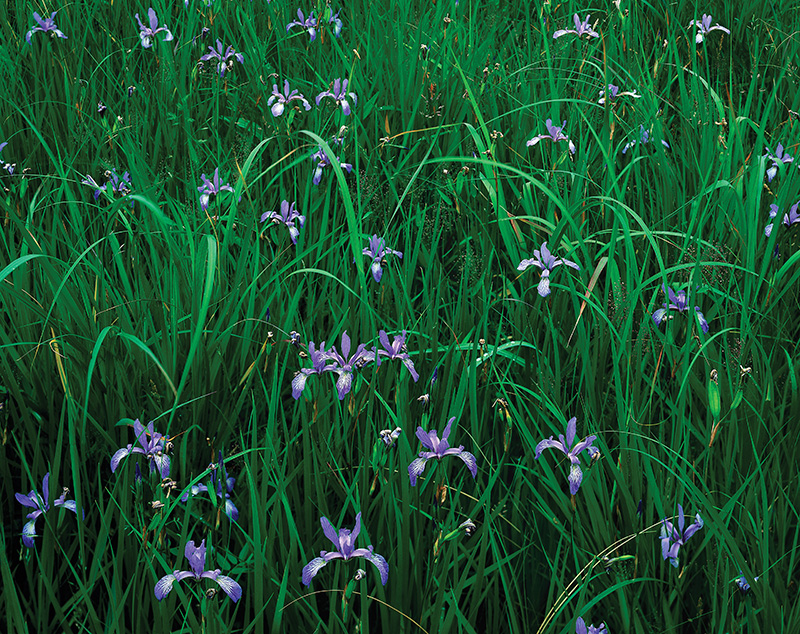
Slender Blue Flags, Lyme, CT, June 1981 © William Burt.
These then are the spring woodland species I’ve long most associated with the Lymes (I haven’t fiddled here with the various blue violets, and decline to waste our time with any aliens); but in East Haddam, just a few miles to the north, there was (and is, I hope) an exceptionally rich piece of the woods I often stopped to see in April, and came to think of as “the garden.” It lay at the foot of a steep rocky slope, and while no bigger than the usual backyard, it hosted at least half a dozen species I’d seen nowhere else in all the lower river valley. Red Trillium; Round-lobed Hepatica; Herb Robert; Blue Cohosh; Downy Yellow Violet—these are the ones I can recall; and I remember also two rather unusual ferns, in sites within no more than half a mile of this rich little “garden”: Rusty Woodsia (a single plant); and Mountain Spleenwort (many hundreds).
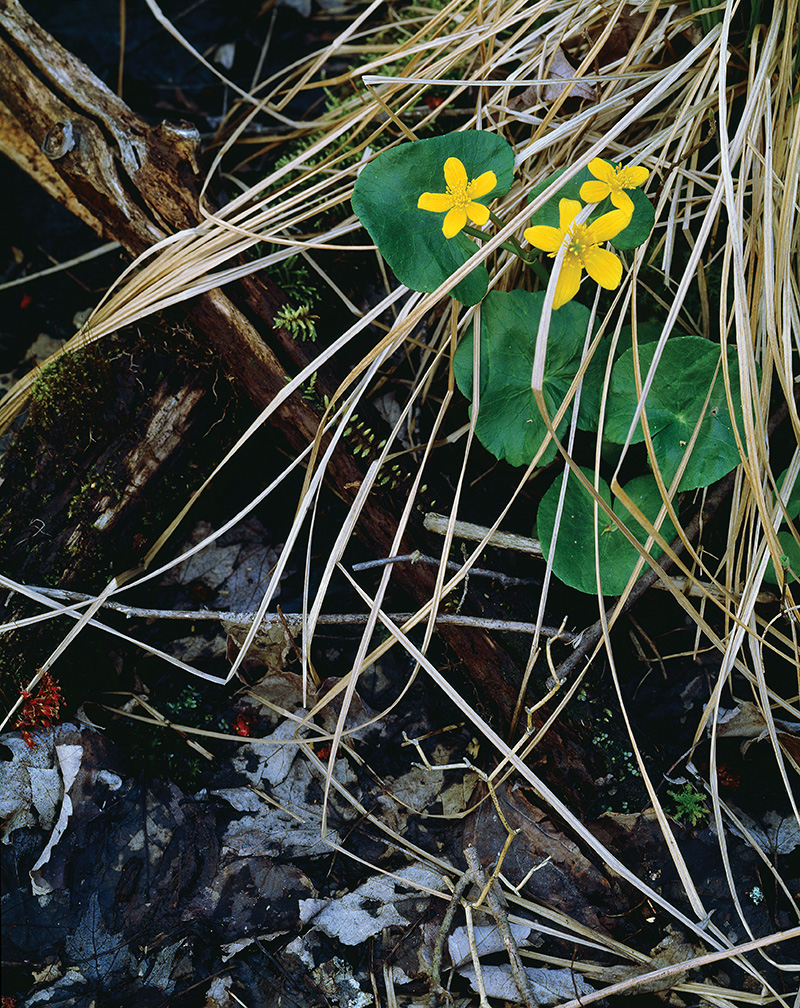
Marsh Marigold and Sedge, Old Lyme, CT, April 1976 © William Burt.
Also in East Haddam, and well known to botanists, is a wet boggy meadow that serves both as a mid-winter skating rink, and then come June as a wildflower Eden: for the orchidologist, especially. Calopogons and the paler Rose Pagonias glow like cool pink flames among the grasses, and among these two are likely a few blooms of that most delicate and ladylike of irises, the Slender Blue Flag. And then a few miles to the north, I can’t recall exactly where, I once passed by what had appeared to be a quaking Sphagnum bog; and sure enough. I walked out on the floating mat to find it strewn with blooming Rose Pagonias, and only Rose Pagonias: there was little else out there but some short wispy grass.
 But let’s get back to the Connecticut itself: at the wet southern end of Selden Island, Hadlyme, where I once met with a botanical anomaly. When I stepped out of my skiff one day in early May I found the sweetflag marshes strewn with the bright yellows of Marsh Marigolds; and you just don’t find those yellows anywhere except along some babbling and fast-moving stream. I don’t, at least; yet here was not a mere stray plant or two but a whole marshful, in the middle of a wide, slow-moving tidal river, only six miles from the salty waters at its mouth. So as they say, go figure.
But let’s get back to the Connecticut itself: at the wet southern end of Selden Island, Hadlyme, where I once met with a botanical anomaly. When I stepped out of my skiff one day in early May I found the sweetflag marshes strewn with the bright yellows of Marsh Marigolds; and you just don’t find those yellows anywhere except along some babbling and fast-moving stream. I don’t, at least; yet here was not a mere stray plant or two but a whole marshful, in the middle of a wide, slow-moving tidal river, only six miles from the salty waters at its mouth. So as they say, go figure.
Next stop down the river then, about a mile south of the marsh at Selden, is Whalebone Creek; and should you have a kayak or canoe or other means of aquatic travel, there’s no better place to browse for such freshwater blooms of summer as Bur Marigold and Bottle Gentian, Turtlehead, New York and New England Asters, and the blood-red Cardinal Flower. And in spring, two seriously uncommon species can be found in flower, neither of which you’re likely to find elsewhere in the region. One is Bog Bean (or Buckbean), which is actually rather common in far northern wetlands; and the other, much less common still here in Connecticut, is Golden Club. The only other Golden Clubs I’ve seen hereabouts were in a small bog in interior Old Lyme.
Another two miles down the river brings us to the cattail marshes of Lord’s Cove in Lyme, and a long flanking strip of wooded upland that thins southward, and gives way to a wet switchgrass meadow. Some years the meadow is much wetter than in others, and in 1981 (you can believe me) it was wet enough to suit that loveliest of irises, the Slender Blue Flag. In one small area the blooms were bunched so close together that they sparked my instant interest: photographs! I hoofed it to the car, hauled out the camera and returned, set up and waited for the clouds to snuff the sun; and when they did, I took my shot. But then before I could expose a second sheet the sun burned through again, this time for good; so there was nothing for it but to pack it up, and hope I’d got it right with one.
I had. But it’s down at the very mouth of the great river, less than two miles to the south, that the best possibilities await. I speak of course of the Spartina marshes of and about Great Island: not the salty tide-lashed “low marsh,” but the “high marsh” meadows in which the fine grasses grow: Saltmeadow Cordgrass (Spartina patens), Blackgrass (Juncus gerardi), and Spikegrass (Distichlis spicata). Unlike the upland woods, of course, a salt marsh needn’t squeeze its blooming season into a mere week or two of spring before its sunlight is shut off. Its flowers can afford to wait until mid-summer, and they do—with one bright yellow-flowering exception: Silverweed. By the first days of May its sunny blooms have pushed up through; and by mid-June, they’re gone.
Well on into July, the marsh remains a monochrome. But if you care to poke around, you’ll find such funky little green jobs as the fleshy Glassworts (or Salicornias); Seaside Plantain; and the tiny Lilaeopsis: a mere trifle of a plant, scarcely an inch in height, yet inexplicably some botanists take pains to seek it out. The only fetching one of these green-only plants to my eye is the wand-like Seaside Arrowgrass, which is essentially a foot-long stem with bead-like “flowers” strung along the forward end.
By early August, then, it’s happening. The showy Rose Mallow (or Swamp Rosemallow) is in full bloom along the coast and on up-river sparingly to Lyme and even farther, if and where there’s adequate salinity. We all know the posh pink flower (it’s the size of a man’s open palm, and a good eye can spot it at 200 yards); but there’s also a less common white form of the flower, with a deep red center: the Crimson-eyed Rosemallow. Another showy feature of the summer marsh, and equally well known, is Seaside Goldenrod. It pervades all marshes in the estuary, with again the one proviso: adequate salinity.
Some salt meadow species are considerably less showy: Seaside Gerardia, for one (its small pink blooms are negligible, at best); and both Annual and Perennial Salt Marsh Asters. The two asters are both pleasant enough—their whitish flower rays are tinged in varying degrees with lilac, lavender, or blue—but a comparison consigns the Annual at once to a sure second place. Its flower heads are so much smaller, and the rays themselves so short as to be nearly indistinguishable; while those of the Perennial are nearly twice as large, and daisy-like, and really rather handsome. And besides, they gave me a good photograph some years ago.
The dullest of them all to my eye is the omnipresent Salt Marsh Fleabane. Its flower heads are an odd sort of pinkish purple, which in any but the brightest sunlight has the drab and almost sickly aspect of an old, browned fabric, such as a Miss Havisham would wear. But let’s forget the cheerless Fleabane, and conclude with a bright beauty of the salt grass rarely seen here or anywhere about the estuary: the elusive Sea Pink, or Marsh Pink.
For years I’d kept a hopeful eye out every time I stepped into a salt marsh; but I never saw a one. Then one year in the last few days of August, I stopped back to see a favorite marsh in eastern Maryland to find it pooled in places with a hazy pink—and there they were, afloat among the fine Spartina grasses by the hundreds, like suspended galaxies. I’d trudged that marsh so many times before, but never in late August: I had no idea.
Years later I heard from another fellow who had kept an eye out for the Sea Pink here at the mouth of the Connecticut—and found it. He was the late Donald Swan, a Trustee Emeritus of the Yale University Herbarium (a serious botanist indeed); and having seen one of my Maryland photographs he’d written both to compare notes, and to report that he had found a few plants just across the river in Old Saybrook: at a station “listed in a field trip report of a group from the Connecticut Botanical Society in 1955.” So surely it lurks somewhere over here on this side of the river, too...
There is one other salt marsh beauty of late summer, and a common one: Sea Lavender. Its blooms are minuscule—about a sixteenth of an inch across—and yet its multitudes can tinge the meadows with a blueish mist.
I did just call the plant another “beauty,” didn’t I, and I suppose it might well be, in its own modest way; but it’s no Sea Pink. That one is beyond compare.
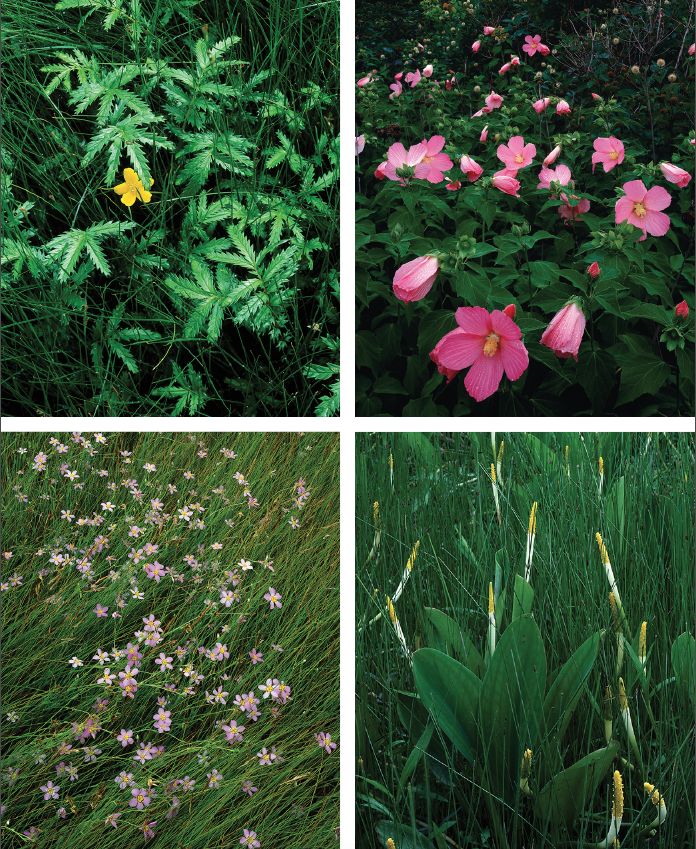
Top Left: Silverweed & Blackgrass, Old Lyme, CT, May 1981. Top Right: Swamp Rosemallows, Old Lyme, CT, August 1981.
Bottom Left: Sea Pinks & Spartina Elliott Island, MD, August 1992. Bottom Right: Golden Clubs, Hadlyme, CT, September 1982. © William Burt.
